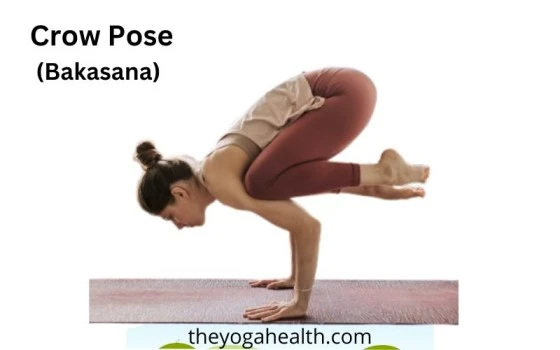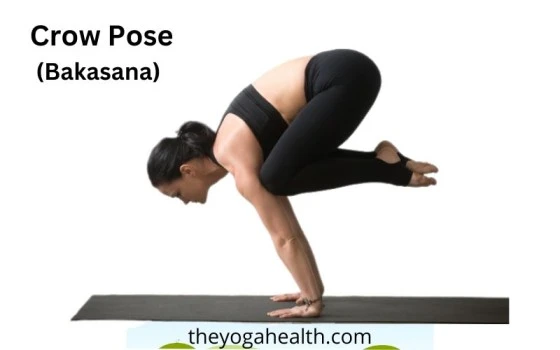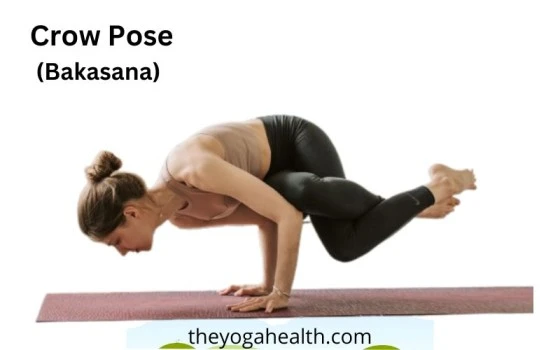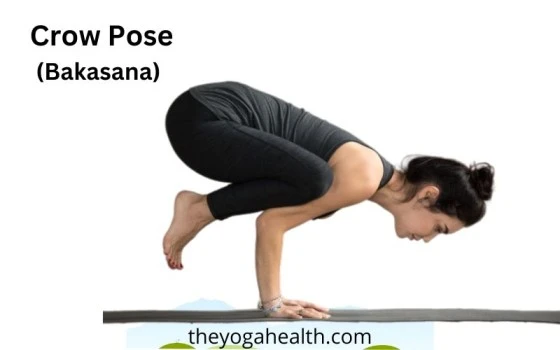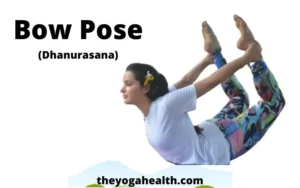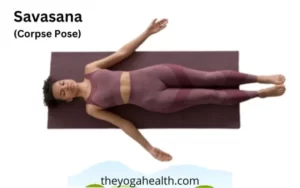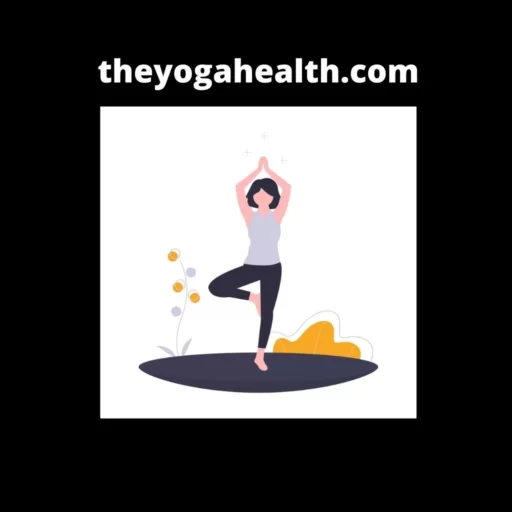The Crow Pose, also known as Bakasana in Sanskrit, is one of the important pose of Hatha Yoga. In this article we will explore Crow Pose benefits, meaning, step by step instructions, variations, precautions and tips for practicing. This Pose is an empowering arm balance pose that strengthens the body and mind of the practitioner.
Table of Contents
Crow Pose Benefits and Meaning:
Crow Pose, is an arm balancing yoga posture that combines strength, balance, and focus. It involves balancing the body on the hands with the knees resting on the back of the upper arms.
The pose resembles a crow, which inspired its name. Crow Pose embodies the essence of the majestic crow, a bird revered in many cultures for its intelligence and adaptability.
Meaning of Bakasana:
“Bakasna” consists of two Sanskrit language words, “Baka” means “Crow” and “Asana” means “pose or posture”. Crow is a symbol of balance and fearlessness and wisdom as per yogic traditions. As you practice this asana, embody the qualities of the crow and embrace the challenges with confidence and grace.
Basic Details of Crow Pose:
| Sanskrit name | Bakasana |
| English Name | Crow Pose |
| Difficulty Level | Intermediate |
| Type | Arm Balance |
| Target Area | Arms, Shoulders, Core |
| Pronunciation | BAH-kah-sah-nah |
Crow Pose Benefits:
This Pose offers a lot of benefits for the body and mind, which are as follows:
1. Strengthens the Arms and Shoulders:
In this Pose the entire body weight is to be balanced on the hands that builds strength in the arms and shoulders. It enhances the strength and stability of the upper body.
2. Tones the Abdominal Muscles:
Engaging the core in this Pose tones and strengthens the abdominal muscles, promoting better posture and core stability.
3. Improves Balance and Focus:
Maintaining balance in this Pose requires focus and concentration, which enhances mind-body awareness.
4. Develops Wrist Strength:
Regular practice of this Pose helps in developing wrist strength and flexibility.
5. Stimulates the Abdominal Organs:
The compression on the abdomen in this Pose stimulates the abdominal organs, aiding in digestion and detoxification.
6. Overcoming Fear
The fear of falling forward can hold back many from attempting Crow Pose. Conquer this fear by practicing near a wall for support or with a yoga buddy to provide encouragement.
7. Mindfulness
This Pose offers a moment of mindfulness, bringing your attention to the present moment and the sensations in your body as you find balance and stability.
8. Body Awareness
As you practice Crow Pose, you’ll develop a heightened sense of body awareness, becoming more in tune with your breath, muscles, and alignment.
9. Boosting Confidence
Successfully holding Crow Pose instills a sense of confidence and self-assurance. It shows that with practice and determination, you can achieve challenging goals.
10. Core Activation
Core engagement is crucial in this asana to lift and balance the body. Regular practice of the pose helps strengthen and tone the core muscles.
11. Inner Transformation
As you progress in this asana, you may notice changes beyond physical strength. Embrace the inner transformation and newfound resilience in your journey.
12. Building Arm Strength
This asana is a remarkable pose to develop arm strength, making everyday activities that involve lifting or carrying objects more manageable.
13. Improving Concentration
Maintaining balance in this asana requires unwavering concentration, which can carry over to improve focus in daily tasks and activities.
14. Toning the Back Muscles
Balancing on the hands in this asana engages the muscles of the back, helping to tone and strengthen this important region of the body.
15. The Power of Persistence
Achieving this asana may take time and practice, teaching the value of perseverance and dedication in reaching goals.
16. Overcoming Mental Barriers
Conquering the fear of balancing on the hands in this asana can help you overcome mental barriers in other aspects of life, encouraging you to embrace challenges with courage.
17. Spinal Health
The extension of the spine in this asana promotes spinal health and flexibility, relieving tension and discomfort in the back.
18. Improved Digestion
The compression of the abdomen in this asana stimulates the digestive organs, aiding in digestion and promoting a healthy digestive system.
19. Full-Body Engagement
Balancing on the hands in this asana requires full-body engagement, encouraging integration of the mind and body in the practice.
20. Stress Relief
The focused and mindful practice of this asana can serve as a stress-relieving tool, allowing you to find calmness amidst the chaos of daily life.
21. Breath Control
Maintaining steady breathing in this asana enhances breath control, providing a sense of tranquility and grounding.
22. The Art of Falling
Falling is a natural part of learning this asana, teaching the art of resilience and encouraging you to get back up and try again.
23. Balance in Life
Just as you balance on your hands in this asana, strive to find balance in all aspects of life, nourishing both physical and mental well-being.
Crow Pose Benefits in Following Ailments:
Crow Pose may offer therapeutic benefits for the following conditions:
Sciatica:
Crow Pose stretches and strengthens the lower back and hips, which can be beneficial for those with sciatica.
Mild Backache:
The engagement of core muscles in this Pose can alleviate mild backache and improve back strength.
How to Do Crow Pose:
Follow these steps by steps instructions to practice Crow Pose:
- Start in a squat position, keeping your feet a hip-width apart.
- Place your hands on the yoga mat, shoulder width apart.
- In order to create a stable foundation for your hands spread your fingers wide.
- Now slightly bend your elbows and place your knees on the back of your upper arms. Try to keep it as close to your armpits as possible.
- Now you have to shift your weight forward and lift your feet off the ground.
- Balance on yourself on your hands, keep looking forward and your back straight.
Hold the pose for a few breaths, gradually increasing the duration with practice.
Crow Pose Variations:
As you progress in your Crow Pose practice, you can explore the following variations:
1. Crane Pose (Kakasana):
Crane Pose is a variation of Crow Pose where the arms are straight rather than bent. This variation challenges the arm and wrist strength further. As shown in the picture below:
2. One-Legged Crow Pose:
It is an advanced variation of the pose, in this variation one knee rests on the upper arm, while the other leg extends straight back. This variation of the pose is also known as Flying Crow Pose. In this variation the balance of the entire body comes on the one side.
Balancing on one leg intensifies the core engagement. If you have good and solid foundation of basic pose then you can challenge yourself with this advanced variation.
3. On Thigh Crow Pose:
In this variation one leg is folded and thigh of one leg is placed on both the upper arms and legs in the back are rolled with each other. This variation is repeated using both legs. As shown in the above picture.
4. Crow Pose to Headstand
In this advanced variation, from the basic crow pose the Headstand is performed. For doing this variation, first perform the basic crow pose, slowly the head is placed on the floor and now the weight of the body will be shifted from the hands towards the head. After that slowly both legs are lifted upwards towards the roof to perform the full headstand.
Tips To Beginners:
Use a yoga block under your feet for added elevation and support as you learn to balance on your hands.
Practice near a wall for support and to build confidence in the pose.
Focus on engaging your core muscles to help you lift and balance your body.
How to Safely Practice Crow Pose:
Follow these safety tips to avoid strain or injury during Crow Pose:
Warm-Up:
Prepare your body with a gentle warm-up, including wrist stretches and hip-opening poses.
Engage the Core:
Keep your core muscles engaged throughout the pose to support your body weight.
Soft Landing:
Practice Crow Pose on a soft surface, such as a yoga mat or carpet, to cushion any accidental falls.
How Much Time to Practice Crow Pose:
For beginners, start with holding this pose for a few breaths and gradually increase the duration as you build strength and confidence. Aim for three to five breaths initially and extend the time as you progress.
Preparatory and Follow-Up Poses of Crow Pose:
Preparatory Poses:
Plank Pose (Phalakasana)
Malasana (Garland Pose)
Adho Mukha Svanasana (Downward Facing Dog)
Follow-Up Poses:
Chaturanga Dandasana (Four-Limbed Staff Pose)
Urdhva Mukha Svanasana (Upward Facing Dog)
Crow Pose Precautions:
Take the following precautions to practice this asana safely:
Wrist Injuries:
If you have wrist injuries or conditions, approach this asana with caution or avoid it altogether. Consider modifications or consult a healthcare professional.
Pregnancy:
Pregnant individuals should refrain from practicing this asana, as it places pressure on the abdomen.
Crow Pose Contraindications:
Avoid this asana if you have the following conditions:
Recent Abdominal Surgery:
If you’ve had abdominal surgery, avoid this asana until you’ve fully healed and received approval from your healthcare provider.
Carpal Tunnel Syndrome:
Individuals with carpal tunnel syndrome should avoid putting excessive pressure on the wrists in this asana.
High Blood Pressure:
Individuals with high blood pressure should refrain from practicing Crow Pose due to the intensity of the pose and the potential strain it may put on the cardiovascular system.
Tips for Successful Crow Pose Practice:
Gaze Forward:
Maintain a soft gaze a few inches ahead of your hands to help with balance and focus.
Keep Elbows Bent:
Avoid locking your elbows; keep them slightly bent to support your body weight.
Crow Pose Modifications for Beginners
For beginners, this pose may initially seem challenging, but with the right modifications, it becomes more accessible:
Supported Crow Pose:
Practice this pose with a cushion or yoga block placed in front of you. Rest your forehead on the support as you lift your feet off the ground, providing a sense of security.
Half Crow Pose:
Begin in a squat position, place one knee on the back of the arm, and lift the opposite foot off the ground. This modified version helps build strength and balance before attempting the full pose.
Personal Experience
Let’s hear from George, a yoga enthusiast, about his journey with Crow Pose:
“When I first attempted this Pose, I was skeptical about balancing on my hands. But under the able guidance of my teacher, I learned the proper alignment to balance myself in the pose. Now, this Pose has become a symbol of strength and fearlessness in my practice.”
Incorporating Crow Pose into Your Practice
To incorporate this pose into your yoga routine:
Warm-Up:
Prepare your body with Sun Salutations and gentle stretches.
Core Work:
Engage in core-strengthening poses like Boat Pose and Plank Pose.
Practice:
Practice this Pose for a few breaths, gradually extending the duration.
Cool-Down:
Wind down with calming poses like Child’s Pose and Savasana.
Conclusion For Crow Pose Benefits:
Mastering this pose is a journey of self-discovery and growth. To achieve maximum Crow Pose benefits, embrace the challenges of the pose with an open heart and approach each practice with joy and curiosity.
Continue to practice with patience, mindfulness, and an open heart, and may this pose lead you to new heights of strength and self-awareness.
FAQs:
Q1: How to Do Crow Pose?
A: Crow Pose, also known as Bakasana, is an arm balance yoga pose. To do Crow Pose:
· Sit in a squatting position.
· Now Place your hands shoulder-width apart on your yoga mat.
· Now gently bend your elbows and place your knees on the backs of your upper arms.
· After that shift your body weight forward and lift your feet off the ground.
· Now your hands should support the weight of your entire body.
Q2: Why Can’t I Do Crow Pose?
A: If you’re struggling with Crow Pose, it’s common and okay. It could be due to:
Lack of core strength and balance.
Fear of falling forward.
Wrist or arm flexibility.
Not using proper alignment.
Practice and patience will help you progress.
Q3: What Is Crow Pose?
A: Crow Pose (Bakasana) is an arm balance that resembles a crow. It involves balancing on your hands with your knees on the back of your upper arms.
Q4: What Muscles Does Crow Pose Work?
A: Crow Pose works multiple muscles:
Arms: Strengthening your arm muscles.
Core: Engaging your core for balance.
Shoulders: Building shoulder strength.
Wrists: Developing wrist stability.
Back: Toning the back muscles.
Q5: How Long to Hold Crow Pose?
A: For beginners, start with holding this Pose for a few breaths. Gradually increase the duration as you gain strength and confidence. Aim for 10-20 seconds.
Q6: Why Does Crow Pose Hurt My Arms?
A: If Crow Pose hurts your arms, it could be due to improper alignment, excessive pressure on the wrists, or lack of strength. Ensure you distribute weight evenly and engage your core.
Q7: What Is Crow Pose Good For?
A: Crow Pose offers various benefits:
Strengthens arms, core, and shoulders.
Improves balance and concentration.
Tones abdominal muscles.
Stimulates digestion.
Boosts self-confidence and mental focus.
Do share your experience of doing Crow Pose (Bakasana) and if You have any question or comments regarding this Pose, you can mention so in the comments section below.


